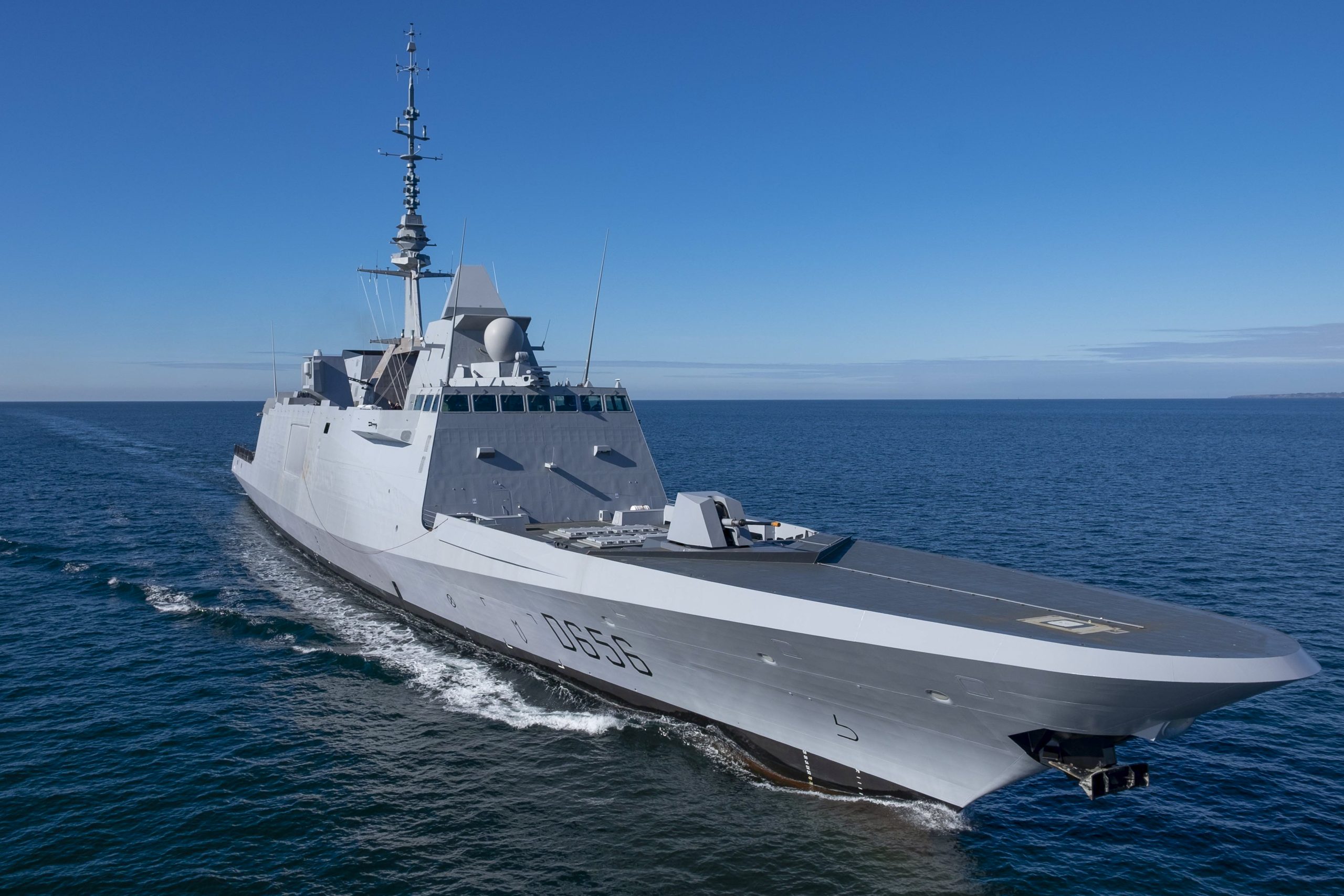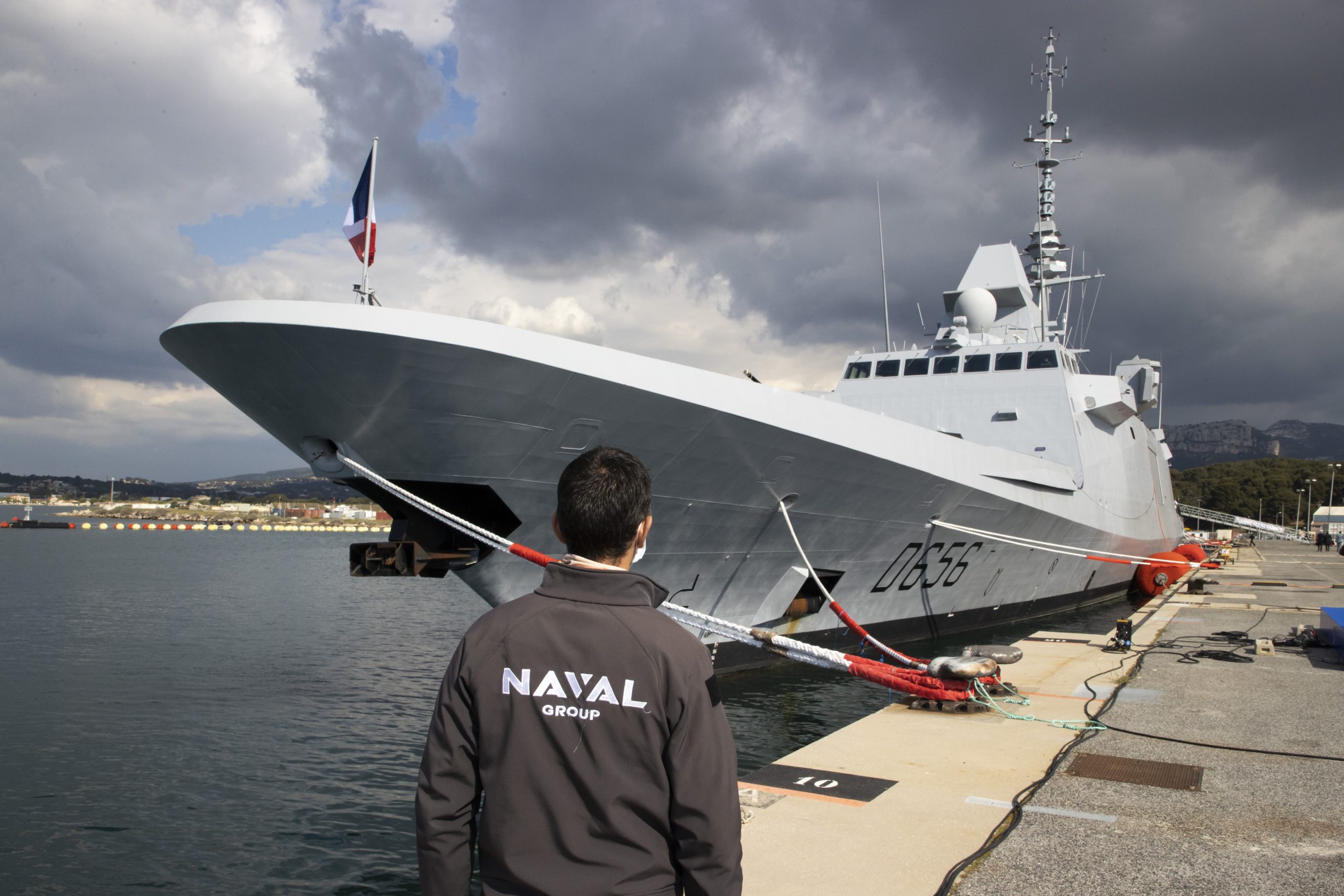The FREMM DA Alsace was launched April 18, 2019 at the Naval Group shipyard of Lorient thirteen months after its keel laying. It is the ninth FREMM frigate built by Naval Group and the seventh one for the French Navy.
According to Naval Group: “On April 12, 2021 in Toulon, in the presence of Florence Parly, Minister of the Armed Forces, Naval Group delivered, in accordance with its calendar commitments and expected performance, the FREMM DA Alsace.
“Intended for the French Navy, it is the first of the two air defense frigates of the FREMM program.
“This is the seventh European Multimissions FREMM Frigate ordered by the General Directorate of Armaments (DGA) for the benefit of the French Navy, and whose program management has been entrusted to OCCAR 1.”
The video below provided by Naval Group highlights the build of the new frigate.
Pierre Tran provided an update on Naval Group in a piece published on April 1, 2021:
Paris – An early French order for a third frigate for defense and intervention helped Naval Group boost competitiveness on its offer of the FDI warship to Greece, executive chairman Pierre Eric Pommellet said March 30.
“It is good news for the competitiveness of our shipyards,” he said in a video press conference.
Pommellet was referring to the March 29 announcement by the armed forces minister, Florence Parly, that France was bringing forward the delivery of two FDI warships by a year to 2025.
“I have the pleasure to announce that we will speed up the delivery of the FDI 2 and 3, the frigates Admiral Louzeau and Admiral Castex,” she said at Naval Group’s shipyard at Lorient, western France. “In this way, we will have three intervention frigates a year earlier than planned.”
Earlier production of a third FDI will help a cost cutting drive, with NG seeking to shed €124 million ($145 million) of costs. Competitiveness could always be improved, Pommellet said, declining to give a value on that French order, reflecting Parly’s withholding that information.
Those second and third FDI vessels will be delivered nine months apart in the first and last quarter of 2025, specialist website Mer et Marine reported. Delivery of the remaining FDI 4 and FDI 5 vessels remained 2027 and 2029.
Delivery of the first FDI, the Admiral Ronarc’h ordered in April 2017, was due in 2024, the Direction Générale de l’Armement procurement office said in a March 29 statement.
That first FDI had been scheduled for delivery in 2023, but NG had temporarily closed shipyards last year due to the pandemic crisis.
The FDI, bearing a brandname of Belharra, is aimed at the highly competitive export market, seen as necessary for the financial health of the company.
A cut in costs was needed, as Greece had last July found NG’s €2.5 billion offer for two frigates too expensive, business website La Tribune reported March 23.
Naval Group made a fresh offer mid-March of four FDI warships, with the first to be built at Lorient and three in a Greek shipyard, a defense source said. Those frigates would be armed with the MBDA naval cruise missile, a weapon absent from the five-strong order for the French navy.
France has also offered Greece two secondhand frigates from the French navy for free, to bridge the gap until delivery of the first FDI, the source said.
Local Content on Australian Submarines
On the plan to build 12 attack submarines, NG has committed to ensure 60 percent of local content from the Australian supply chain, said Pommellet, with that commitment applying from today and respected “by the end of the program.”
There has been media pressure for a pledge on local content, and that topic was high on the agenda when Pommellet flew to Australia last month for high level talks.
The submarine project pointed up the shift of NG from essentially a French company to becoming a global actor with an Australian industrial base.
There would be significant industrial investment and Australia would be part of the global supply for NG, he said.
NG was already working with local partners, including family owned firms and engineers, to build facilities at Adelaide port, he said, with the Thales Australian unit among the partners.
BAE Systems was also at the harbour, he said, working on its Australian navy frigate.
There will be “no worries” for local content on the submarine project, he said, pointing up the significance of Australian sovereignty.
NG was in negotiation for the next stage in the project, which is basic design and likely to last two to three years, followed by detailed design, and then manufacture, he said. Long-term programs were managed in stages, and it was up to the government to decide it had chosen the right partner as each phase came up. That reflected national sovereignty.
NG’s Australian unit has committed to at least 60 percent local content, created almost 300 jobs, and plans to double its local workforce this year, the company said in a March 23 statement. That recruitment was part of preparation for building a hull qualification section in Adelaide in 2023 and building the first submarine pressure hull in the following year.
More than 120 local firms have registered interest to be tier one capability partners, to build major parts for the boat, the company said. That was in response to announcement of the first local manufacturing package worth almost A$900 million.
Next Generation Aircraft Carrier
The DGA awarded March 19 a two-year contract to NG, Chantiers de l’Atlantique, a commercial shipyard, and TechnicAtome, a nuclear engineering company, to conduct further studies on a next generation aircraft carrier, the procurement office said in a March 29 statement.
The study follows previous preliminary studies which led the president, Emmanuel Macron, to opt for a nuclear powered carrier to replace the Charles de Gaulle carrier.
When these studies are completed in 2023, a more detailed, three-year study will follow, to allow industry to make an offer for building the carrier, the DGA said. There will also be a safety study for the nuclear engine.
The aim is to start building the ship in 2025, hold sea trials in 2036, and enter service in 2038, to avoid a capability gap before the Charles de Gaulle is retired from service, the DGA said.
NG has formed a joint venture with Chantiers de l’Atlantique to work on the new carrier, with the former to receive 2/3 of revenue and the latter 1/3, Pommellet said.
That joint venture, named MO PA for aircraft carrier prime contractor, will be 65 percent held by NG and 35 percent by Chantiers de l’Atlantique. That JV company name evoked memories of a previous project, named MO PA 2, which worked on studies for a sister ship to the Charles de Gaulle. That MO PA 2 project was cancelled for lack of funds.
The joint venture aims to be clear on management of the program, with each partner clear on what the partners will manage.
NG will be overall architect, and integrator for combat, navigation and aviation systems, catapults and arresting cables, subsystems for the nuclear boilers, and integration of the boilers into the ship.
Chantiers de l’Atlantique will build the ship and manage major systems such as electric propulsion, living quarters and auxiliary systems.
Financial Hit
A speeded up order for a third frigate for the French navy reflected the need for NG to plug a looming gap for work at Lorient and winning state support.
NG had been waiting for that announcement for some time, Pommellet said
The government holds 62.5 percent of NG, while Thales, an electronics company, holds 35 percent.
The shut down of the yards in the first half last year hit 2020 sales and profit, and hurt the company’s export drive.
That lock down led to 2020 revenue falling to €3.3 billion from €3.7 billion in the previous year, with a profit margin dropping to 2.6 percent compared to 7.6 percent.
The 2021 target for the profit margin was 7.5 percent of sales, the company said.
The pandemic crisis cut down export prospects, hampered by cancellation of the Euronaval trade show last year and the Paris air show this year, Pommellet said. Trade shows were an important means of pitching directly to prospective clients.
Domestic deals accounted for 70 percent of 2020 sales, with 30 percent from exports, he said. The 2021 target was 60:40 percent, and Australia was a major factor.
Pommellet said he took note of business magazine L’Usine Nouvelle challenging the company for withholding a press release on 2020 financial results, which were published in a March 24 interview with La Tribune.




